The Southeast Asia Disaster Risk Insurance Facility, or SEADRIF, provides participating ASEAN countries with insurance and risk management solutions against climate shocks and natural disasters.
When disaster strikes, economic upheaval is felt at every level of society - from governments, to businesses, to households. Faced with the devastating and irreversible effects of lives lost and livelihoods uprooted, nations and their people may take years, or even decades, to recover and rebuild.
Rising frequency in disasters and increased exposure mean that countries need to strengthen their fiscal resilience in preparation for sudden adversities. The SEADRIF Initiative, established with ASEAN+3 endorsement, provides technical and financial solutions to help prepare for such situations.
The SEADRIF Insurance Company was created to provide disaster risk financing and insurance products to participating countries, and oversees the first regional catastrophe risk product. The Company is licensed as a general insurance company by the Monetary Authority of Singapore (MAS), under the jurisdiction of Singapore.
The Company offers the Initiative’s first regional insurance product for Lao PDR (with ongoing discussions with other countries), and is supported by the World Bank’s technical expertise and with initial capitalization from Japan and Singapore. Over time, the intention is to develop more insurance solutions, responsive to the needs of SEADRIF member countries. The first product combines innovative technology with parametric insurance so that in the event of a disaster, payouts are made quickly to support urgent relief needs and early recovery operations.
Aside from financial solutions, the SEADRIF Initiative also provides technical solutions, including knowledge and capacity building services to help governments strengthen financial resilience and reduce the financial protection gap across the region.
Read more about
Governance
The Flood Risk Monitoring tool
Parametric insurance
Having plans and pre-arranged funding in place before a disaster puts governments in a position to better protect the poorest and most vulnerable communities. Many of the most susceptible populations do not have their own insurance protection and are reliant on their government to provide post-disaster relief and reconstruction resources.
In the aftermath of a disaster, countries often experience budget constraints and uncertainty when it comes to relief funds from international partners, rendering support to the poor and vulnerable areas unpredictable or slow. Many households are pushed into financial hardships, leading them to turn to harmful coping strategies such as the sale of productive assets or taking children out of school for income generation, potentially eradicating years of progress.
In the critical moments after a disaster, the more governments are equipped for emergency response, the sooner they can start the recovery and reconstruction process. The SEADRIF Insurance Company aims to make payouts to insured governments as an additional source of financial support for the country and its population.
SEADRIF has received grant funds for three purposes: 1) initial capitalization; 2) operating expenses; and 3) technical services and risk management support to member countries. These grants are funded by Japan and Singapore.
To ensure SEADRIF is focused on serving its member countries and their people, it’s important to define what SEADRIF is not and what it doesn’t do.
The SEADRIF Initiative comprises four-tiers: 1) the SEADRIF Trust, 2) the Sub-trust A (created for the Lao PDR insurance facility), 3) the Trustee, and 4) the Insurance Company.
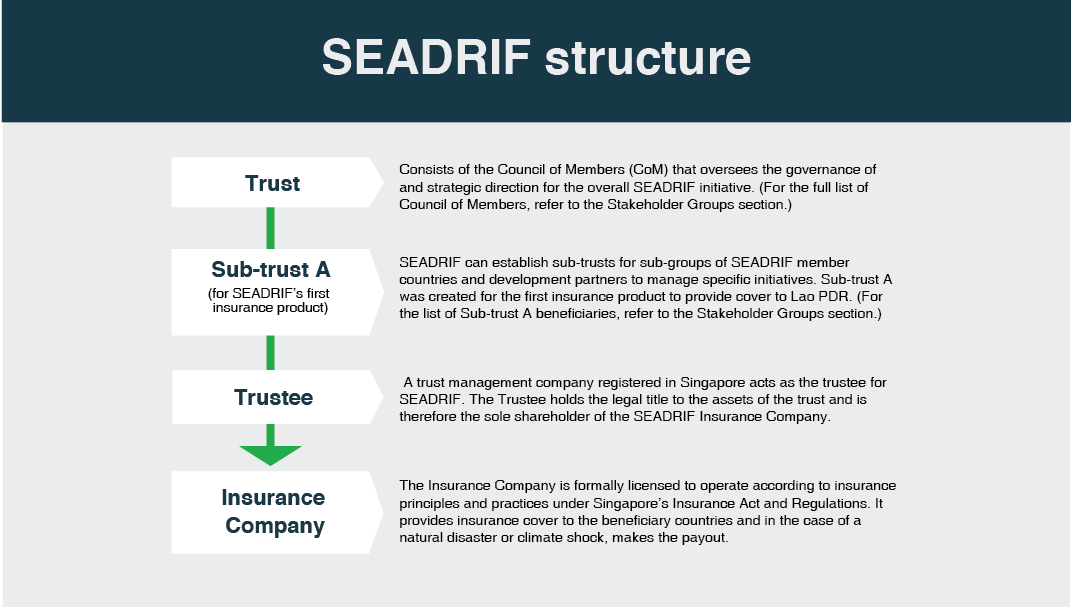
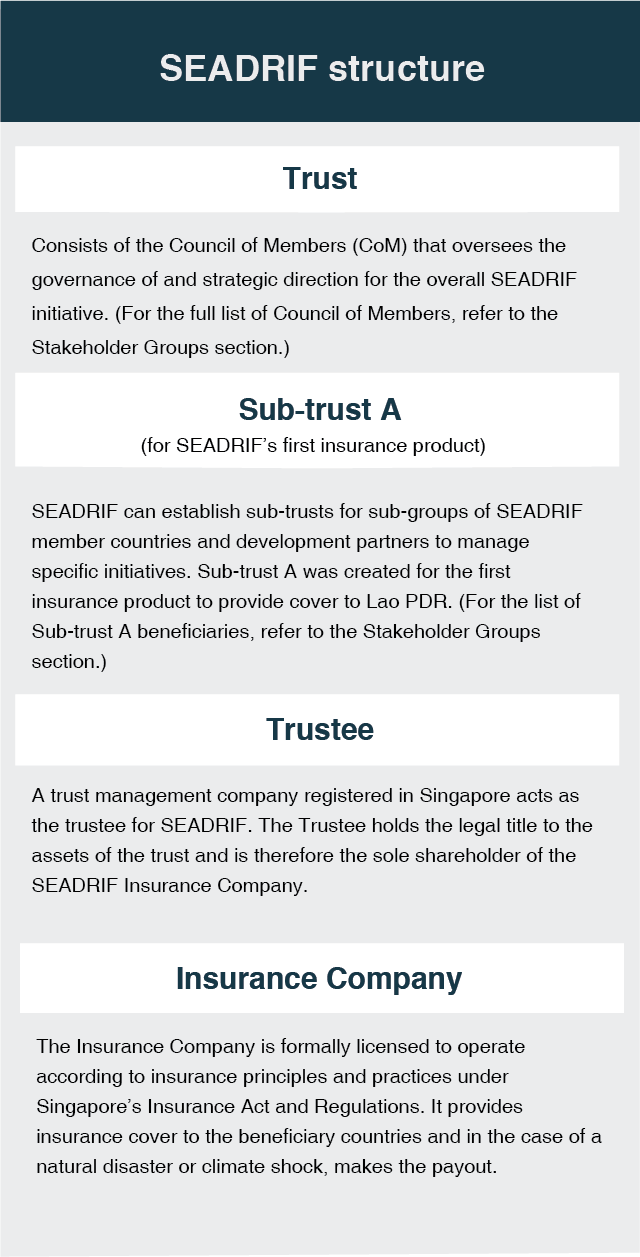
SEADRIF Stakeholder groups:
SEADRIF’s first product provides insurance to Lao PDR against climate shocks and natural disasters. The insurance policy has a three year period and consists of two complementary components: the parametric component and the finite risk component.
The core feature of SEADRIF’s first insurance product is its parametric component which uses a stepped payout structure. The structure has fixed parameters that correspond to predefined levels of the modelled number of people affected by a flood, which trigger pre-agreed payout amounts. Specifically, 40% of the policy limit is payable in the event of a ‘medium’ disaster, and 100% of the policy limit is payable in the case of a ‘severe’ disaster. The parametric component must comprise a minimum of 50% of the total premium paid.
The finite risk component provides countries with protection against events that might not trigger a payout under the strictly objective rules of the parametric component. This could be due to: 1) basis risk; 2) small flood events that don’t trigger a payout under the parametric component; or 3) losses that are caused by natural disasters which are not flood-related, but for which the insured country requires a degree of financial support. To qualify for a payout under this component, the insured country is required to provide evidence that a disaster event has occurred.
Read more about
Parametric component
Finite risk component
Basis risk
Basis risk arises when the index used as the basis for payouts does not fully correlate with the actual losses incurred. This is a feature of all parametric insurance because triggers are set against a model or proxy, which can never fully reflect reality. For example, there can be instances when a payout isn’t made after a severe event despite relatively high losses (known as negative basis risk events) or when a payout is made following a minor event with relatively low losses (known as positive basis risk events).
The SEADRIF Company has calibrated the Flood Risk Monitoring Tool and parametric trigger thresholds to historical events to minimize basis risk. But despite efforts to reduce basis risk, it can never be eliminated entirely, so a finite risk component was incorporated into the first insurance product to minimize the negative impacts of basis risk.
Read more about
The Flood Risk Monitoring tool
Finite risk component
Read more about
Basis risk
Parametric component
Unlike traditional indemnity insurance, the countries determine how much premium they can pay, and the SEADRIF Insurance Company calculates the level of coverage it can offer in return.
Factors taken into consideration when designing this product include: i) the countries’ ability to pay their premium; ii) simplicity of the product such that it can be easily understood; iii) the willingness of the international market to provide reinsurance at a competitive rate so that SEADRIF Insurance is protected against heavy losses; and iv) SEADRIF being a sustainable initiative on a long term basis.
Reinsurance ensures that the SEADRIF Insurance Company is always able to meet eligible claims with timely payouts, even in years with severe disaster events. Reinsurance maximizes the efficient use of capital and enhances SEADRIF Insurance Company's ability to offer higher limits of cover.
SEADRIF works on a commercial-basis Public-Private Partnership (PPP) model with reinsurers to maintain long-term sustainability of the initiative.
Parametric insurance determines the payout amount based on predefined estimations of the severity of a disaster event. At the core of the parametric component sits the SEADRIF Flood Risk Monitoring Tool, which provides near real-time assessments of the magnitude of a flood and its potential impact. The tool combines various data sets to determine the severity of the event in terms of how likely it is to occur: 1-in-8 years (meaning, on average, an event with this severity or worse occurs every 8 years) for a medium-scale event or 1-in-20 years for severe events. This then determines whether the beneficiary will receive a 40% payout (for medium events) or 100% (for severe events).
Introduced over two decades ago, parametric products have seen growing applications by governments. Between 2007 and 2017, 26 countries across Africa, the Pacific, and the Caribbean and Central America joined three separate sovereign catastrophe risk pools and purchased parametric catastrophe risk insurance for an aggregate coverage of $870 million and an aggregate premium volume of $56.6 million, backed by more than 30 reinsurance companies. Collectively, the three pools made $105 million in payouts during that same period. For example, within 15 days after two category 5 hurricanes in 2017, Irma and Maria, devastated the Caribbean islands, CCRIF SPC (also parametric-based) made $29.6 million in payouts to six Caribbean countries.
Source: (2017, November 14). What Makes Catastrophe Risk Pools Work: Lessons for Policymakers. www.worldbank.org
The finite risk component is designed to provide financing for costs resulting from events which do not trigger the parametric component of the insurance policy. This can include basis risk events and other instances where events aren’t eligible for payouts, such as losses that don’t meet the threshold for a payout under the parametric component or when the disaster event is not a flood and therefore not covered.
The total payout amount from the finite risk component for the three-year policy period is available in three tranches. In Year 1, a third is available and if no payout is made in Year 1, then up to two-thirds is available in Year 2. If no payouts are made in Years 1 and 2, then up to the full amount is claimable in Year 3. The total amount of cover is defined, i.e. finite.
Read more about
Basis risk
Parametric component
The severity of an event is calculated based on the estimated number of people who live in areas flooded by at least 25 cm of water. It is expressed as ‘medium’ for 1-in-8 year events (i.e. events with this severity or worse are expected to occur once every 8 years or at an annual probability of occurrence of 12.5%) and as ‘severe’ for 1-in-20 year flood events (i.e. events with this severity or worse are expected to occur once every 20 years or at an annual probability of occurrence of 5%).
Since the parametric component only pays out in the case of medium and severe events, a smaller event may be eligible for a payout under the finite risk component.
To ensure fairness, each country's hydrological history and total population is taken into account so that event severity is calibrated to each country.
Read more about
Parametric component
Finite risk component
To sustain protection for its member countries over the long-term, SEADRIF put in place systems to ensure the initiative and its products work optimally and with transparency.
Internally, controls and mechanisms for structural oversight and governance have been put in place to safeguard SEADRIF against any misuse of funds or conflict of interest. As a whole, the SEADRIF Initiative is not managed for profit and any income or capital will be redeployed in ways that support its sole objective of providing protection to member countries. Below is a non-exhaustive list of measures that have been put in place.
At the organizational level:
In terms of payouts:
The government of Lao PDR renewed the parametric coverage for flooding when the first policy matured in Feb 2024. The SEADRIF Insurance Company updated the policy structure, with the Lao Ministry of Finance and technical partners ensuring alignment with the unique needs of Laos. The parametric trigger has been expanded from 2 levels to 4 levels and thresholds lowered, providing flexibility to address varying risk scenarios.
The strategic partnership between the government of Lao PDR and SEADRIF ensures the continuation of protection for the Laos population against disaster risks and climate shocks.
Read more about
Parametric model
When a flood event meets the threshold to qualify as a medium or severe disaster, no action is required from the insured government. The SEADRIF Company will initiate the process and make the payout. To activate the finite risk component, the country needs to notify the SEADRIF Company and request a payout by providing a proof of loss; if the event is eligible, a payout will be made automatically.
In more detail, here is the step-by-step process.
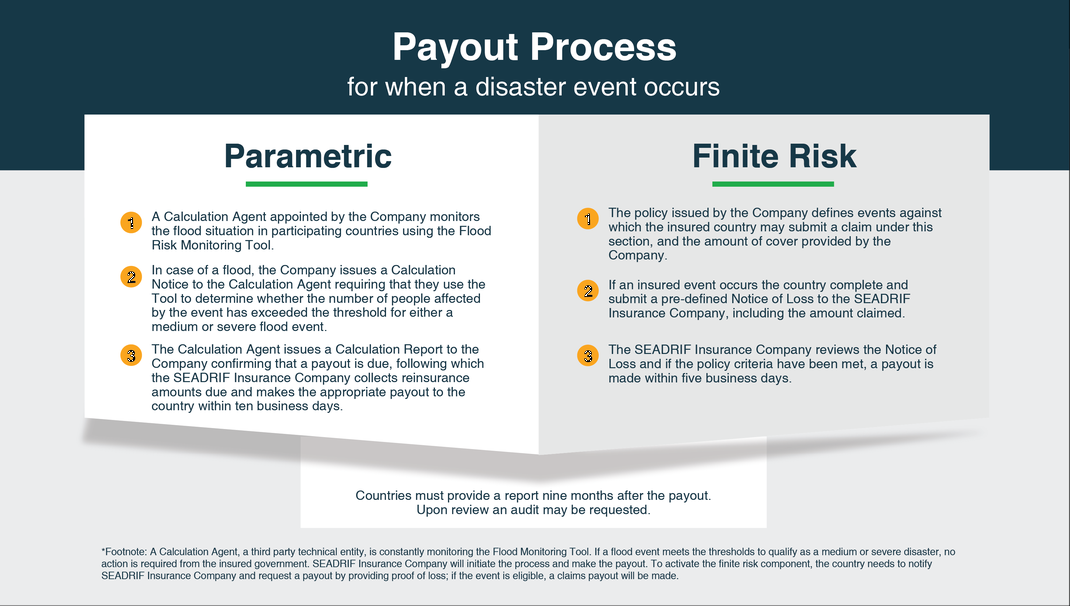
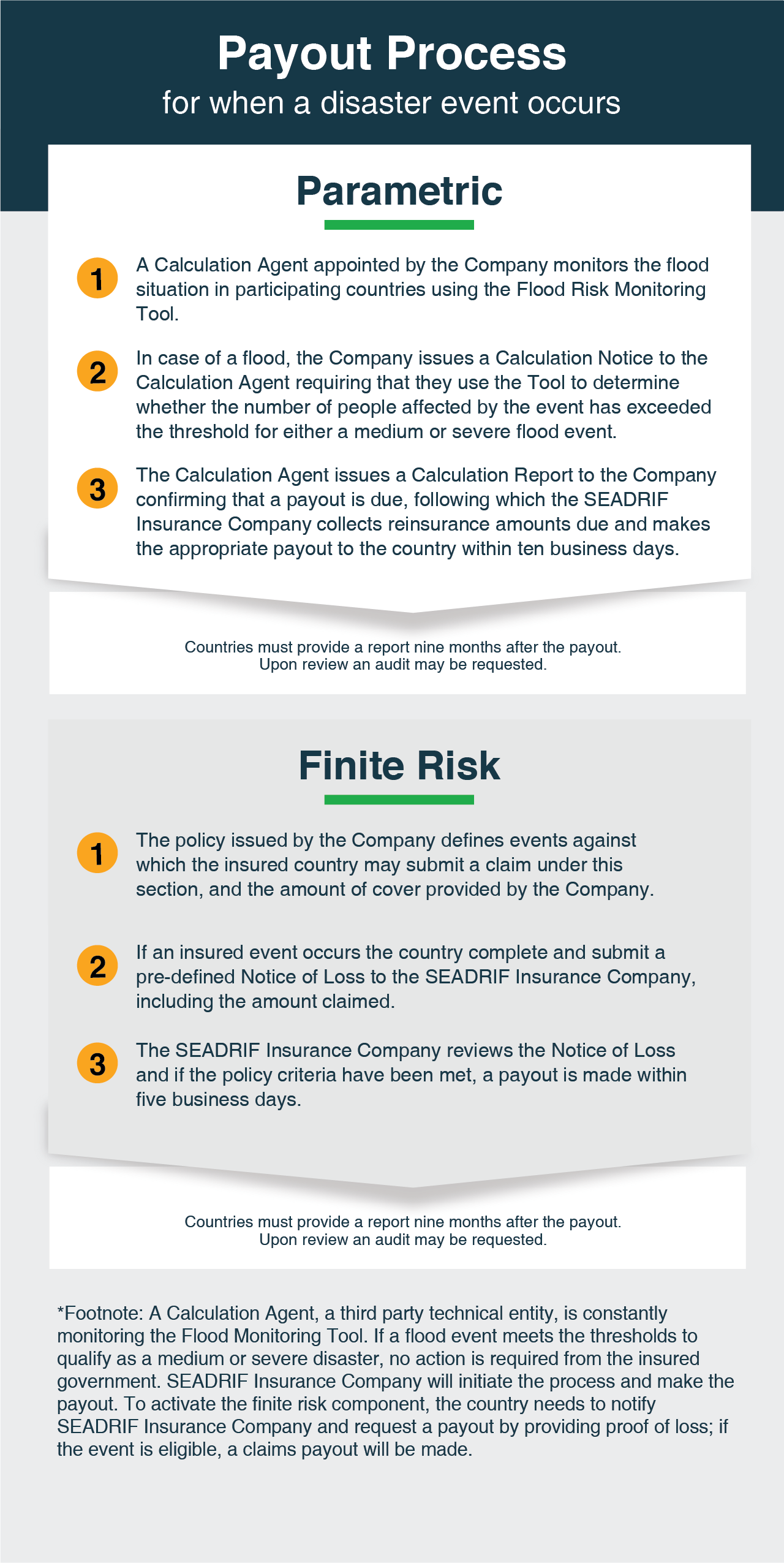
A payout under the parametric component is made as long as the event meets the criteria outlined in the insurance policy. Like any insurance, however, there are circumstances that do not qualify for a payout. For instance, non-flood related disasters such as earthquakes or wind damage from cyclones are not covered so a payout would not be made. Or, in the event of a flood, if the flood does not meet the severity threshold - a medium severity, in the case of the first product - the event will not trigger a payout. In these instances, countries can claim a payout from the finite risk component if the criteria outlined in the insurance policy is met.
Read more about
How does SEADRIF’s first insurance product work
The SEADRIF Insurance Company developed a flood insurance product first in response to a request from its initial member country, Lao PDR. Over the last three decades, floods have affected over 135 million people across ASEAN nations and have caused more financial burden than any other kind of natural disaster. The chart below indicates that the impact of floods is rapidly increasing, making it an ever more urgent priority.
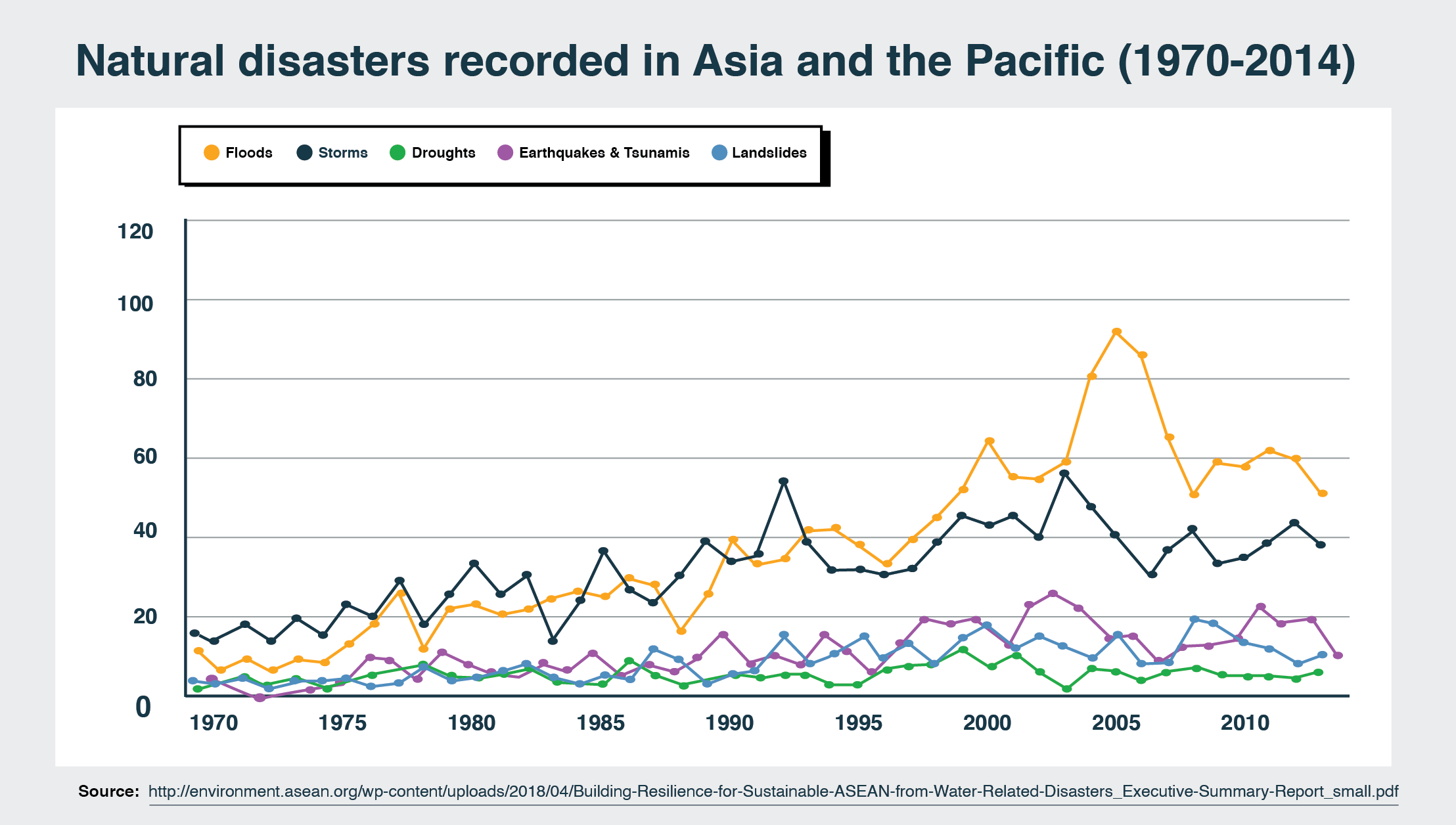
Source: (2017, April). Building Resilience for Sustainable ASEAN from Water-Related Disasters. ASEAN-ROK Cooperation Fund. www.environment.asean.org
The SEADRIF Initiative is working closely with its members to develop additional products that will protect the region against other perils.
The SEADRIF Insurance Company aims to maintain a transparent and simple payout structure, which comprises the following components:
Depending on the circumstances of the event, an event may qualify for both parametric and the finite risk payouts.
SEADRIF’s first insurance product aims to make a parametric component claim payout within ten business days and a finite risk component claim within five business days. Time is of the essence when it comes to disaster management - especially for urgent relief needs and early recovery operations - so SEADRIF’s first insurance product was designed to facilitate quick payouts. Once the payout is made, the insured country’s government manages and distributes the funds through their own systems and processes.
Read more about
How does SEADRIF’s first insurance product work
Payouts are made directly to the insured country and are entirely managed by the respective governments through their own systems and processes. Payouts are provided to support emergency response and paid directly by SEADRIF Insurance Company to the insured country. The payouts are expected to be used in accordance with contingency planning guidelines based on criteria on the use of payouts. Expenditures are solely for goods and services supporting post-disaster emergency relief, response, and recovery, and must not pose substantial or high environmental and social risk, as per the SEADRIF Environmental and Social Management System (ESMS). An exclusions list, covering greenfield projects, military goods or tobacco, amongst others, is included in the ESMS.
Nine months after a payout, beneficiary countries are required to report back on how the funds were used. The members of SEADRIF Sub-Trust A and the World Bank then have the option to request an audit to determine if funds were used appropriately and in line with the contingency plans.
Read more about
SEADRIF Committee
No, SEADRIF is an insurance facility only available to sovereign governments in ASEAN countries and is not available to individuals.
SEADRIF is the first dedicated regional insurance facility for governments that tackles natural and climate disasters in Southeast Asia. Globally, similar solutions include the Caribbean Catastrophe Risk Insurance Facility Segregated Portfolio Company (CCRIF SPC), the African Risk Capacity Ltd (ARC) and the Pacific Catastrophe Risk Assessment and Financing Initiative (PCRAFI). Some countries have also established dedicated insurance facilities domestically, such as the Japan Earthquake Reinsurance or New Zealand’s Earthquake Commission (EQC).
SEADRIF is open to all ASEAN countries. Additional countries are welcome to join this first pool, which currently supports Lao PDR, subject to required preparatory work and agreement by existing members. The SEADRIF Company is also exploring additional products for its member countries.